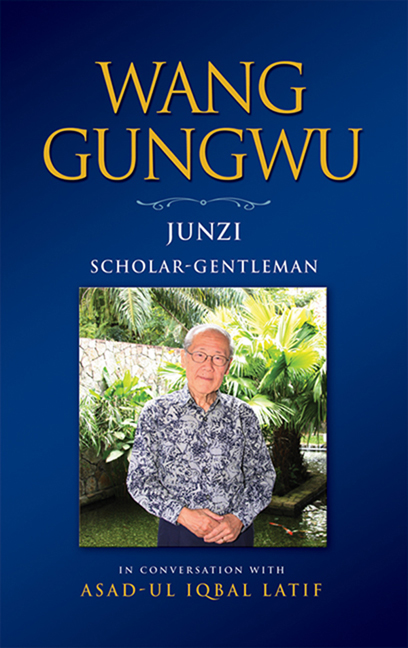Book contents
- Frontmatter
- Contents
- Foreword
- Wang Gungwu: Friend, Mentor and Role Model
- Junzi: Scholar-Gentleman
- INTERVIEWS WITH PROFESSOR WANG GUNGWU
- Being Chinese in Malaya
- Malaysia, Singapore and Australia
- Vietnam
- Hong Kong
- China Rising
- Taiwan, Japan and India
- The United States, Terrorism and War
- Half a Century of Marriage: An Interview with Mrs Margaret Wang
- Appendices
- Index
- Plate Section
Malaysia, Singapore and Australia
from INTERVIEWS WITH PROFESSOR WANG GUNGWU
Published online by Cambridge University Press: 09 November 2017
- Frontmatter
- Contents
- Foreword
- Wang Gungwu: Friend, Mentor and Role Model
- Junzi: Scholar-Gentleman
- INTERVIEWS WITH PROFESSOR WANG GUNGWU
- Being Chinese in Malaya
- Malaysia, Singapore and Australia
- Vietnam
- Hong Kong
- China Rising
- Taiwan, Japan and India
- The United States, Terrorism and War
- Half a Century of Marriage: An Interview with Mrs Margaret Wang
- Appendices
- Index
- Plate Section
Summary
How did you respond to Singapore's Merger with Malaya, Sabah and Sarawak to form Malaysia?
On my return from China, I went to the University of Malaya in 1949, went on to study at the University of London, and came back to teach at the University of Malaya. I returned from London in 1957, the year the Federation of Malaya became independent. I saw that as a great beginning and decided to identify with the Federation. Of course, Singapore was out of it because it was still a British colony. The University of Malaya was actually in Singapore. But because Malaya was independent, the Malayan government, quite reasonably, said that the University of Malaya should really be in Kuala Lumpur and not in Singapore. There were big discussions about that and then they came to a compromise, which was that there would still be one University of Malaya with a division in Singapore and a division in Kuala Lumpur. In 1959, people were asked to decide which division they wanted to work in. For me, it was very obvious: I came from Malaya and so I asked to go to Kuala Lumpur. That was a clear indication that my real identity lay in the new country that was being established. And the idea of building a new university for that country to help to shape that nation was something very attractive to me. I certainly believed that that was something that I wanted to do. So I offered to go to KL.
The question of Singapore's future was left vague. Only in 1960–61 did this idea of Merger come up, with the Prime Minister of Malaya agreeing to the British proposal, but with great reservations, because the Malay leadership in Kuala Lumpur was always concerned about adding so many Chinese from Singapore to the population and changing the demographic pattern too much. So the new plan brought in Sabah and Sarawak. Of course, we were aware that demography was the real reason for the creation of Malaysia. Singapore, too, was aware of this.
- Type
- Chapter
- Information
- Wang GungwuJunzi: Scholar-Gentleman in Conversation with Asad-ul Iqbal Latif, pp. 25 - 50Publisher: ISEAS–Yusof Ishak InstitutePrint publication year: 2010

